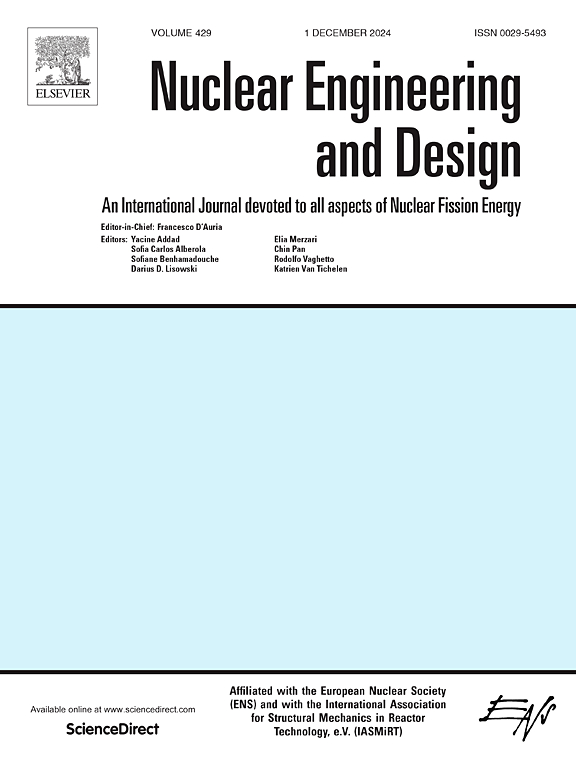基于Clark近似的核燃料循环设施地震风险评估简化量化方法
IF 2.1
3区 工程技术
Q1 NUCLEAR SCIENCE & TECHNOLOGY
引用次数: 0
摘要
核燃料循环设施是通过建立核燃料循环来支持能源有效利用的重要组成部分。但是,考虑到这些设施的地震风险低于核电站,在进行地震风险评估时,采用简化的评估方法是合理的。本文提出了一种简化的地震风险评估量化方法。传统的简化方法简化了评估过程,只选择有代表性的组成部分,往往忽略了其他部分。相比之下,该方法在考虑所有分量的同时,简化了所需的计算过程。克拉克近似是将两个正态分布的最大值近似为一个新的正态分布的一种数学方法。将该方法与蒙特卡罗模拟和传统简化方法的地震概率风险评估结果进行了比较,验证了该方法的有效性。结果表明,虽然在完全独立的条件下,本文方法与蒙特卡罗方法相比高估了低失效概率的高置信度,相对差值为0.15,但总体的厂级脆弱性曲线总体在5%和95%置信度的脆弱性曲线范围内。该方法考虑了相关破坏的影响,这是地震风险评估的关键。因此,这种方法能够以一种简化的方式对核燃料循环设施进行地震风险评估,而不影响准确性,可能有助于审查风险缓解措施,并为这些设施制定风险知情的安全条例。本文章由计算机程序翻译,如有差异,请以英文原文为准。
A simplified quantification method for seismic risk assessment of nuclear fuel cycle facilities using Clark approximation
Nuclear fuel cycle facilities are important elements for supporting the efficient use of energy resources by establishing a nuclear fuel cycle. However, given that the risks of these facilities are lower than those of nuclear power plants, it is considered reasonable to apply simplified assessment methods when evaluating seismic risks. In this study, a simplified quantification method is proposed for seismic risk assessment at such facilities. Traditional simplified methods have streamlined the assessment process by selecting only representative components, often neglecting others. In contrast, the proposed method simplifies the required computational processes while considering all components by applying Clark approximation. Clark approximation is a mathematical method for approximating the maximum of two normal distributions as a new normal distribution. The proposed method was validated by comparing its seismic probabilistic risk assessment with those performed using Monte Carlo simulations and traditional simplified methods. Results showed that although the proposed method overestimated the high confidence of low probability of failure by a relative difference of 0.15 compared with that of the Monte Carlo method under completely independent condition, the overall plant-level fragility curve was generally within the range of the 5% and 95% confidence fragility curves. The proposed method accounted for the impact of correlated failure, which is critical in seismic risk assessments. Thus, this method enabled the seismic risk assessment of nuclear fuel cycle facilities in a simplified manner without compromising accuracy, potentially contributing to examining risk mitigation measures and developing risk-informed safety regulations for these facilities.
求助全文
通过发布文献求助,成功后即可免费获取论文全文。
去求助
来源期刊

Nuclear Engineering and Design
工程技术-核科学技术
CiteScore
3.40
自引率
11.80%
发文量
377
审稿时长
5 months
期刊介绍:
Nuclear Engineering and Design covers the wide range of disciplines involved in the engineering, design, safety and construction of nuclear fission reactors. The Editors welcome papers both on applied and innovative aspects and developments in nuclear science and technology.
Fundamentals of Reactor Design include:
• Thermal-Hydraulics and Core Physics
• Safety Analysis, Risk Assessment (PSA)
• Structural and Mechanical Engineering
• Materials Science
• Fuel Behavior and Design
• Structural Plant Design
• Engineering of Reactor Components
• Experiments
Aspects beyond fundamentals of Reactor Design covered:
• Accident Mitigation Measures
• Reactor Control Systems
• Licensing Issues
• Safeguard Engineering
• Economy of Plants
• Reprocessing / Waste Disposal
• Applications of Nuclear Energy
• Maintenance
• Decommissioning
Papers on new reactor ideas and developments (Generation IV reactors) such as inherently safe modular HTRs, High Performance LWRs/HWRs and LMFBs/GFR will be considered; Actinide Burners, Accelerator Driven Systems, Energy Amplifiers and other special designs of power and research reactors and their applications are also encouraged.
 求助内容:
求助内容: 应助结果提醒方式:
应助结果提醒方式:


